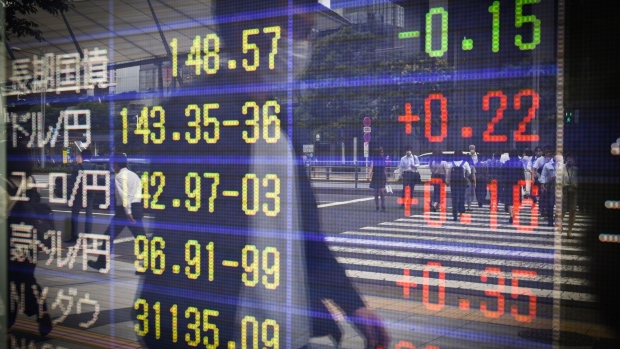Oct 17, 2022
Yen Traders on Alert for Intervention as Currency Extends Slide
, Bloomberg News

(Bloomberg) -- The yen took a further step toward the closely watched 150 per dollar level, keeping investors on high alert for possible intervention to support the currency.
In volatile trade, Japan’s currency fell to as low as 149.29 yen in morning trading in London, its lowest since 1990, before bouncing back quickly. The move came after the country’s prime minister and central bank chief have insisted they would stick with their current policy mix amid criticism that it is contributing to the yen’s slide.
The currency slipped even as the greenback lost ground against all other Group-of-10 peers. It’s now at a level last seen 32 years ago, amid rapid-fire warnings from authorities trying to dissuade traders from testing their intervention strategy.
“There’s absolutely no change to our stance that we’ll respond appropriately against excessive moves,” Finance Minister Shunichi Suzuki told reporters Tuesday. “We’ll be watching markets with a sense of urgency today as well.”
Yen watchers have said officials are likely focused on the speed of declines and won’t necessarily have a price in mind at which they’ll act again. But some have noted that 150 is a key psychological level for Japan and a breach would likely increase pressure on the government to act again.
“If dollar-yen rises past the symbolic 150 level, price action will naturally accelerate, so they probably want to halt it before then or buy time,” said Yuji Saito, executive director at Credit Agricole CIB’s foreign-exchange department in Tokyo. “Price action over the past few days match their condition for action. They could step in any time between 149-150.”
Multilateral Agreements
Given multilateral agreements that warn against disorderly currency movements, Japanese authorities will find it less difficult to get tacit support for intervention if they are seen to be responding to “excessive volatility.”
Speaking in parliament, Prime Minister Fumio Kishida flagged the significance of a Group of Seven statement on currencies last week that recognized significant moves in various currencies this year and heightened volatility.
His comments and those of Bank of Japan Governor Haruhiko Kuroda suggested a renewed commitment to a de facto division of labor that sees the central bank keeping rates down and the government taking measures to mitigate the pain of rising prices fueled partly by the weaker yen, while keeping up its warnings on intervention.
The Japanese currency has slumped this year as traders focused on the widening yield gap between the US and Japan, with the former hiking rates aggressively and the latter keeping them at rock-bottom levels to boost the economy. That encourages investors to seek out the more attractive returns in dollar assets compared to ones in Japan.
Kuroda indicated he doesn’t expect the yen to keep weakening in the long run, by saying that the currency doesn’t move in parallel with interest-rate differentials over the longer term. He rebuffed a lawmaker’s call to quit as concern grows over the yen’s slide.
A rapid drop to 145.90 per dollar last month triggered the nation’s first intervention to support the yen in 24 years.
“With the US backing the strong dollar, the USD/JPY’s uptrend appears unstoppable,” said Eiichiro Miura, general manager of the fixed-income department at Nissay Asset Management Corp. in Tokyo. “The momentum will likely halt only when the Fed starts cutting rates, or a risk scenario becomes a reality, such as when global financial markets destabilize.”
Stealth Mode
There has also been speculation that Japan could be using subtle ways to slow the yen’s slide. Top currency official Masato Kanda said last month that stealth intervention was among the possible options for the government, adding the finance ministry wouldn’t necessarily confirm each intervention when it takes place.
Suzuki declined to comment on the possibility of stealth intervention Tuesday.
Traders Mull Possibility of Japan’s Stealth Yen Intervention
“Dollar-yen at 150 is looking to be merely a passing point,” said Nissay Asset’s Miura. “Markets are seeing that, in light of history, intervention impact won’t last long.”
(Updates prices throughout)
©2022 Bloomberg L.P.





